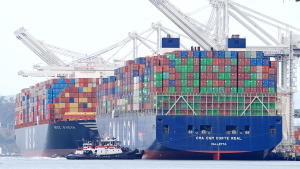The downward trend in the copper-to-gold price-per-ounce ratio points to a slowing global economy as well as a further decrease in demand and a lower price for copper in the short-term. Long-term projections from global miners and investment bankers, however, speak of recovery.
The copper-to-gold ratio goes south
The copper-to-gold ratio is one of the stronger indicators of global economic health, directly correlated with economic trends. When the economy is growing, the demand for copper rises and investments in gold as a stable asset go down, increasing the ratio. On the flip side, economic contraction results in a rising demand for gold as a “safe haven,” causing the ratio to drop.
The peak of the copper-to-gold ratio was in October 2021. Subsequently, there was another spike in February 2022, followed by a downward trend that continues today. According to data from MacroMicro, the ratio has been declining from a peak of 0.25 in October 2021 to 0.19 at the beginning of July. In the two most recent recessions, the ratio decreased below 0.16.
Copper prices remain low due to dampened global demand
After an initial jump this year in early January, and reaching approximately US$4.23 per pound, copper prices started declining at the end of the month. Current prices for the metal are around $3.68 per pound, with this downward trend likely to continue in the short-term.
Among the reasons for the decrease are the economic slowdown in Europe, the slower than expected recovery of the Chinese economy, Russia’s invasion of Ukraine as well as the $2 billion addition to its supply stockpile by the Democratic Republic of the Congo. However, according to senior commodity strategist at TD Securities, Daniel Ghali, the latter is unlikely to influence the copper market price long-term.
Falling copper inventories in Asia are known to correlate with strong copper demand in China. Recently, however, this correlation has become a less reliable indicator.
According to the Bloomberg article titled, The Mystery Around Declining Copper Stocks Is Puzzling Metals Traders, “Copper stockpiles in the London Metal Exchange’s Asian warehouses stood at 13,950 tons…down by almost 80 per cent this month – a level amounting to less than half a day of China’s national consumption.”
China’s copper demand remains dampened as its economy is still recovering from the slowdown caused by the pandemic. LME copper prices prove this, as the benchmark has recently been bouncing between $3.57 and $3.84 per pound. This range is similar to what prevailed during the pandemic, suggesting a less optimistic view of China’s demand for copper in the short-term.
Copper shortage expected longer-term
Ultimately, over the longer term, a copper shortage will likely prevail. Analysts from Citigroup expect more investment into the sector in the future due to the growing demand from the renewable energy industry and electric vehicles.
In the best-case scenario, total demand is anticipated to reach four billion tons by 2025, with the price reaching $6.70 per pound. However, as the price increases, demand may falter as there will be substantial attempts to substitute other metals for copper in consumer goods and electrical conductors.
The strong demand for copper in the long-term is also supported by continuing investments in new projects being carried out by major global commodity miners with confident outlooks. According to Bold Baatar, Rio Tinto’s head of copper, “Overall, there’s a significant copper shortage in terms of the supply deficit that’s coming out of Latin America and the disruptions that are happening in countries like Peru.”
RIO Tinto is planning to invest approximately $920 million in the Kennecott copper development in Utah to meet growing copper demand in the U.S. The company expects the demand for the metal to grow in the long-term due to the energy transition that is happening globally.
BHP’s current copper guidance points to production of between 1,635 and 1,825 kt (thousands of tonnes) in 2023. This will be an increase of 12 per cent year-over-year from 2022. Currently, the company is working on a copper exploration project in Arizona that will utilize a new copper porphyry mineralized system called Ocelot. It is also spearheading a methodology to help mineral exploration companies locate copper, nickel and other critical resources at an earlier stage.
The largest copper reserves in the sector belong to Southern Copper Corporation (SCCO). The company projects 2023 will see copper production of 939.4 kt, a gain of five per cent year-over-year, with mines in Mexico and Peru sustaining long-term growth. SCCO’s upcoming projects, the El Pilar-Sonora and El Arco-Baja California works, will also add to production. With commercial operations expected to commence in 2025, the first project will produce 36 kt of copper cathodes annually. It’s estimated the second project, with a budgeted investment of $2.9 billion, will reach an annual production level of 190 kt.
Overall, the long-term outlook for copper remains positive despite the current slowdown in demand. Future projects planned by large industry players indicate their confidence in the recovery of the global economy, and their anticipation of higher prices for the red metal going forward, due to the advancement of electric vehicles and renewable energy infrastructure.
Dmytro Konovalov has over 10 years of experience in equity research and analysis for global markets at leading international financial institutions.











Recent Comments
comments for this post are closed